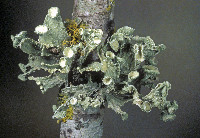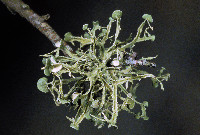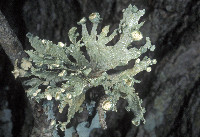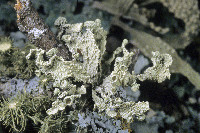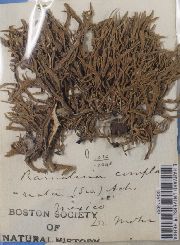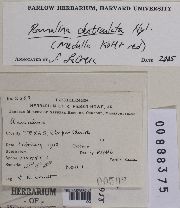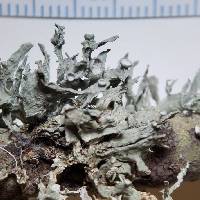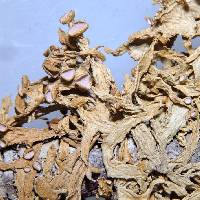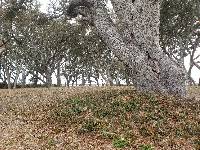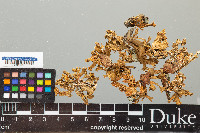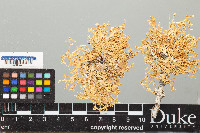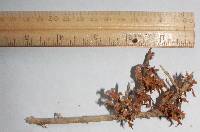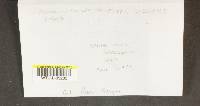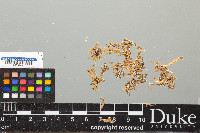
- Home
- Search
- Images
- Species Checklists
- US States: O-Z >
- US National Parks
- Central America
- South America
- US National Parks
- Southern Subpolar Region
|
|
|
|
Family: Ramalinaceae
[Lichen complanatus Sw., moreRamalina calicaris f. complanata (Sw.) Nyl., Ramalina calicaris var. complanata (Sw.) Nyl., Roccella complanata (Sw.) Darb., Roccella complanata var. complanata (Sw.) Darb.] |
Lichenogr. univ.: 599 (1810).—Lichen complanatus Sw., in. Ach., K. Vet. Nya. Handl. 18: 290 (1797). Previously reported from the Galapagos; corticolous, rarely saxicolous, from the coastal throughout the dry into the transition zone, often abundant. Although no Ramalina specimens from COLO were available for comparison, we suspect that all material reported by Weber (1986) as R. complanata belongs to R. aspera. The two species were in the past often confused. Material of R. complanata s.str. in COLO was probably reported as R. denticulata. In comparison with R. aspera thallus lobes of R. complanata are only moderately broadened. They are never hollow or inflated and their medulla typically reacts K+ yellow, slowly turning red (salazinic acid). Like R. aspera, the thallus surface of R. complanata has abundant tuberculate pseudocyphellae. Ramalina darwiniana has a similar chemistry; it also reacts K+ yellow, slowly turning red (salazinic acid). The species was previously not recognized and is described below as new. In contrast to R. complanata, R. darwiniana has lobes that are shiny, and distinctly canaliculate. They are occasionally anastomosing and thus forming holes; the lobe tips are typically curled backwards like shepherds’ crooks. Unlike R. aspera or R. complanata, which have a densely tuberculate pseudocyphellate surface, pseudocyphellae of R. darwiniana are typically restricted to tubercules along the lobe margins. Selected specimens examined. Ecuador: Galápagos: Isabela Island, Turtle Cove, on dead branches, 15 iii 1906, A. Stewart 364 (CAS no. 640922); Volcán Alcedo, highest cinder cone along the trail going up the E-slope, 0˚ 23’ 37” S, 91˚ 1’ 31” W, alt. 250 m, arid lowlands; basalt outcrops, at the bottom scattered Bursera graveolens trees and shrubs of Castela galapageia, on bark, Bursera, 10 iii 2006, A. Aptroot 65026 (CDS no. 31608); Gardner Island, near Española, iv 1899, R.E. Snodgrass s.n. (CAS no. 691735); Española Island, on dead bushes, 25 ix 1996, A. Stewart 368 (CAS no. 640925); Floreana Island, alt. 300 m, on twigs, 11 x 1905, A. Stewart 366 (CAS no. 640923); Pinta Island, along the trail up to the summit from the S-coast, 0˚ 34’ 3” N, 90˚ 44’ 56” W, alt. 233 m, transition zone; open woodland with Bursera graveolens, Zanthoxylum fagara, Pisonia floribunda, Croton scouleri, and few Opuntia galapageia among old lava flows, on bark, stem of Croton scouleri (ca. 3 cm in diam.), SE-exposed; sunny, wind- and rain-exposed, 28 ii 2007, F. Bungartz 5966 (CDS no. 33644); Pinzón Island, along the trail going up from Playa Escondida, N- to W-facing cliff above a crater, 0˚ 36’ 29” S, 90˚ 40’ 14” W, alt. 318 m, dry transition zone with Cordia lutea, Croton scouleri, and at the bottom of the cliff also Scalesia baurii ssp. baurii, on bark, twigs, 16 ii 2006, A. Aptroot 64057 (CDS no. 30618); Rábida Island, alt. 150 m, on dead twigs, 09 xii 1905, A. Stewart 374 (CAS no. 637098); cerca la playa de Rábida, 0˚ 23’ 58” S, 90˚ 42’ 36.1” W, alt. 27 m, con vegetación de zona costera y árida, dominante Bursera graveolens, sobre corteza de Bursera, altura al pecho, 21 vii 2006, F. Nugra 92 (CDS no. 32746); San Cristóbal Island, Wreck Bay, on bark, twigs and branches, 25 i 1996, A. Stewart 365 (CAS no. 640924); northwestern foothills of Media Luna, inland from the NW-coast, 0˚ 43’ 41” S, 89˚ 18’ 44” W, alt. 75 m, arid zone; open woodland of Cordia lutea and Bursera graveolens, on bark, twigs of Cordia lutea; semi-shaded, wind- and rain-exposed, 22 iv 2007, F. Bungartz 6196 (CDS no. 34408); Cerro Colorado, enclosure for Calandrinia galapagosa near the viewpoint on the top, 0˚ 54’ 58” S, 89˚ 26’ 5” W, alt. 350 m, transition zone; open shrubland with Croton scouleri, Macraea laricifolia, Calandrinia galapagosa and few trees among lava boulders on SE-exposed slope of cinder cone, on rock, SE-exposed front of soft and weathered tuff outcrop; sunny, wind- and rain-exposed, 29 iv 2007, F. Bungartz 6710 (CDS no. 34954); Santa Cruz Island, at the North side of the island, along the dirt road to the ash quarry Mina Granilla Roja, 0˚ 36’ 56” S, 90˚ 22’ 3” W, alt. 570 m, lower transition zone; dry semi-deciduous forest with Bursera graveolens and Zanthoxylum fagara, on bark, twigs, 23 ii 2006, A. Aptroot 64562 (CDS no. 31134); along the trail from Puerto Ayora to Bahía Tortuga, 0˚ 44’ 48” S, 90˚ 19’ 14” W, alt. 28 m, decidous forest in arid zone; with Bursea graveolens, Acacia rorundiana, and Opuntia echios; over basalt, on bark, twigs of Acacia insulae-jacobi, sunny, wind- and rain-exposed, 05 i 2006, F. Bungartz 3357 (CDS no. 27024); Santiago Island, ca. 7 km inland from the E-coast, ± at the same latitude as Bahía Sullivan, 0˚ 17’ 4” S, 90˚ 38’ 21” W, alt. 190 m, arid zone; shrubland of Castela galapageia and Macraea laricifolia with occasional trees of Bursera graveolens, on bark, twigs of Castela galapageia; sunny, wind- and rain-exposed, 17 vii 2006, F. Bungartz 5071 (CDS no. 29284); along the trail from Bucanero to Jaboncillos, ca. 2 km SE of Bucanero , 0˚ 10’ 34” S, 90˚ 48’ 55” W, alt. 225 m, arid zone; open woodland with Bursera graveolens, Vallesia glabra, Castela galapageia, Cordia lutea and grasses (e.g, Cenchrus platyacanthus) among basalt boulders and outcrops, on bark, Castela twigs, 22 iii 2006, A. Aptroot 65365 (CDS no. 31951). from: |
|
|
|

![Ramalina complanata Ach. [Bungartz, F. 6404 (CDS 34619)] Ramalina complanata image](/imglib/lichens/CDS_Lichens/00034/CDS_34619_DX_1552_print_1555630610.jpg)




